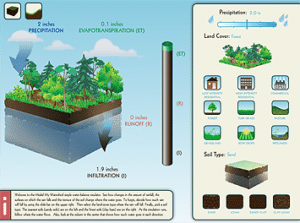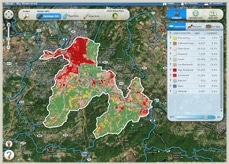By Diane Huskinson

Since we first introduced Model My Watershed® to Upstream Newsletter readers in the fall of 2009 (read “Model My Watershed®: An Innovative Approach to Teaching Environmental Science”), educators at the Stroud™ Water Research Center have reached many new milestones with this innovative project.
The goal was ambitious — to develop an interactive Web tool that enables students to learn about their watershed and the impacts of land use on water quality and the environment; to engage students in the STEM disciplines and get them excited about related careers; to make the tool applicable in regions throughout the United States; and of course, to make it fun for students to use.
When Susan Gill, the Stroud Center’s director of education and public programs, proposed the idea to program officers from the National Science Foundation (NSF), they doubted whether it could be done. It just seemed too good to be true. Yet they believed in it enough to award the Stroud Center a three-year grant.
Now, nearly three years later, what started as a bright idea has unfolded into a real and relevant teaching tool.

Azavea, Inc. has designed the interactive Web tool’s interface to use geographic information systems technology (GIS) with GoogleEarth. Michele C. Adams and Steve Benz, both LEED-certified civil engineers, have developed the hydrologic modeling algorithms.
The result: a dynamic, videogame-like experience that lets students digitally modify land use in their own neighborhoods to examine how urban development or best management practices (BMPs) can affect water quality, flooding, and stormwater runoff. Through the project website, students will eventually interact with STEM professionals via webcasts, videos, and online chat.
Not only is the model done, but students and teachers from local schools in the Schuylkill River and Susquehanna River watersheds are getting the opportunity to test it and provide feedback.
“This application takes real-life decisions into the classroom and allows students to make decisions based on real science,” says Matt Copper, a teacher at Lempeter-Strasburg High School.
The teachers aren’t the only ones who are impressed. Gill has been busy attending meetings on both sides of the country, presenting the project at the American Association for the Advancement of Science Meeting, the Innovative Technology Experiences for Students and Teachers Summit, and the Conference on Cyberlearning Tools for STEM Education. The project was highly praised everywhere she went.
It was also one of two projects developed by Stroud Center scientists and educators to be featured alongside 31 exemplary resources at NSF’s STEM Smart: Lessons Learned From Successful Schools at Drexel University. Among those present were Rep. Chakka Fattah (D-Pa.), Dr. Subra Suresh, director of the NSF, and Mayor Michael Nutter of Philadelphia.
Most recently, Gill, Nanette Marcum-Dietrich of Millersville University, and Carolyn Staudt of the Concord Consortium, traveled to Washington D.C., where NSF program officers encouraged them to apply for two new grants, one for middle school students and one for high school students, to expand the pilot project beyond southeastern Pennsylvania. If awarded these grants, the Stroud Center could bring Model My Watershed® to students and teachers in Virginia, Kansas, Iowa, Alaska, California, and more areas in Pennsylvania through a partnership with the Concord Consortium, a nonprofit educational technology laboratory for science, mathematics, and engineering.
“I couldn’t be more pleased,” says Gill. “We are continuing to move forward, and I’m excited to see the tool reach classrooms and do everything we had hoped it would.”



